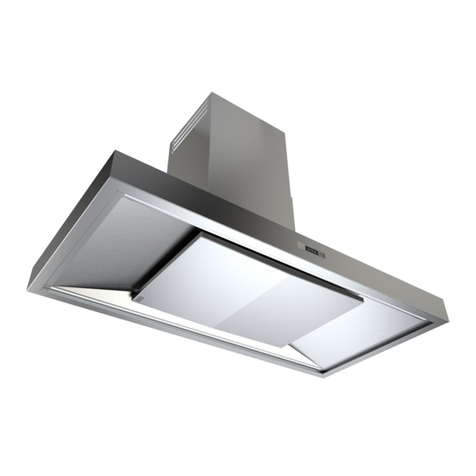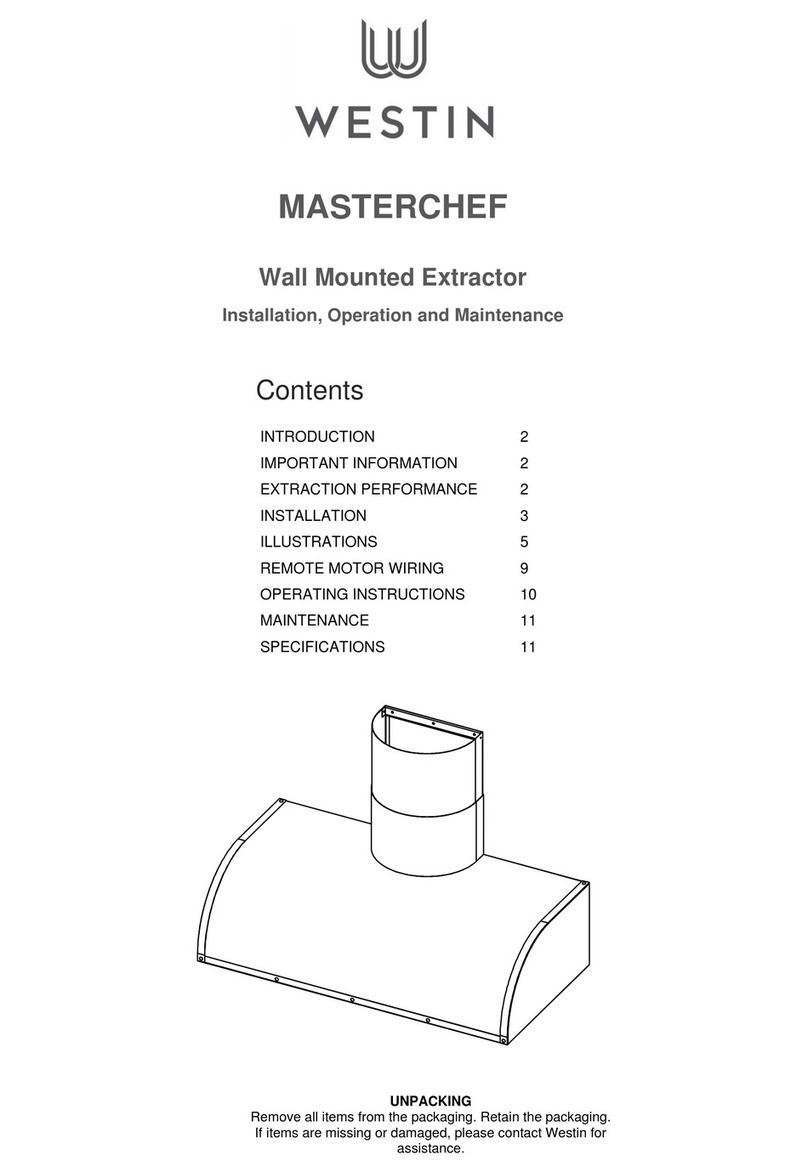W1744 WSW STRATUS MONO Ceiling Extract O&M (Energy Label Version) Apr 20 Page 2 Westin
1. INTRODUCTION
During the cooking process, there will be heat, vapours and fumes
produced. Your Westin Ceiling Extractor has been designed to
complement your kitchen both in looks and performance, in order
to create a good environment for creative cooking.
2. IMPORTANT INFORMATION
The exhaust air must not be discharged into a flue which is used
for exhausting fumes from non-electric appliances such as oil or
gas-fired central heating boilers or gas-fired water heaters, etc.
Requirements of the relevant authorities concerning the discharge
of exhaust air must be complied with.
Pay particular attention to fire risk when frying. To minimise the risk
of fire, all instructions relating to cleaning the grease filter and
removing grease deposits must be adhered to.
Do not flambé under the extractor.
The clearance between the hob burners and the bottom
surface of the cooker hood (extractor) should be within the
following range, unless a greater distance is specified by the
cooking appliance manufacturer:
Hob to underside of the cooker hood clearance distances:
•650mm Minimum above electric hobs.
•760mm Minimum above all gas hobs and gas or electric wok
burners, griddles, fryers, open grills / barbeques.
The minimum distance between the hob and the bottom of the
cooker hood is essential for safety reasons and to prevent
overheating of the extractor and its components.
Please also note that a 90obend in flexible ducting will require
215mm minimum headroom to give a smooth radius with no
kinking.
You are advised to install measures designed to reduce the
incidence of cold draughts entering the property via any ductwork.
For extractors with internal or inline motors, this should, at the
very least, consist of an external duct termination with integrated
non-return flaps (e.g. gravity shutter wall grille/louvre) and/or an
inline backdraught shutter.
For wall-mounted motors, an inline backdraught shutter is
recommended.
3. EXTRACTION PERFORMANCE
This type of extractor is designed to fit into the ceiling void, with
only the glass underside and the edge of the outer steel flange
visible when installed.
Because fumes spread out as they rise, a unit larger than the
hob area is desirable (although not always possible). The drop-
down central extraction system is designed to minimise fume
escape. Warm cooking fumes that do escape tend, initially, to
accumulate in the highest part of the room, so situating the unit
at the highest point is of benefit. It will perform best when it is
situated directly over the hob.
The primary influence on the overall performance of the
extractor is the design of the ducting which takes the exhaust
air from the extractor to the outside. The duct route should be a
prime consideration during the initial stages of the kitchen
design (Westin do not recommend recirculating air back into the
kitchen).
Please note the following:
•Easy access to the duct route during installation is
important. Lack of access may require the “blind” fitting of
flexible ducting (with increased risk of unseen kinks and
impaired efficiency).
•The extractor is provided with a spigot suitable for
connecting 220 x 90mm rectangular ducting. (A duct
connector that converts the rectangular ducting to 150mm
diameter ducting is available upon request).
•Note: to maintain efficient extraction, the cross-sectional
area of the ducting must be 150mm diameter or greater.
•The most efficient configuration is to duct straight through
an outside wall, so try to position the cooker against an
outside wall when designing your kitchen.
•Your extractor can be set to vent to the rear, front, left or
right. Use the exhaust position which gives the shortest
achievable duct route and least number of bends. Joist
positions will often determine what is achievable.
•Rigid 220 x 90 channel system or an equivalent 150mm
round ducting system (available from Westin) will perform
best. The appliance is supplied with a length of 600mm long
flexible ducting that should aid initial installation and should
be pulled taut to prevent significant losses in extraction
efficiency.
•For maximum efficiency, ducting should be kept as short as
possible and as straight as possible with a constant cross-
sectional area equivalent to 150mm diameter ducting.
Bends in the duct will also degrade performance so the
number of bends in a duct run should be kept to a minimum
and be gradual and smooth to prevent turbulence. Avoid
kinks in flexible ducting; pull flexible ducting taut over
straight runs to ensure that theinternal surface isas smooth
as possible.
4. INSTALLATION
The extractor is designed for installation within a cut-out in the
underside of the kitchen ceiling. Alternatively, it may be installed
within a lowered area of ceiling or a soffit panel within your
furniture –remember though that it is desirable to install directly
into the ceiling (see section 3).




































